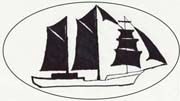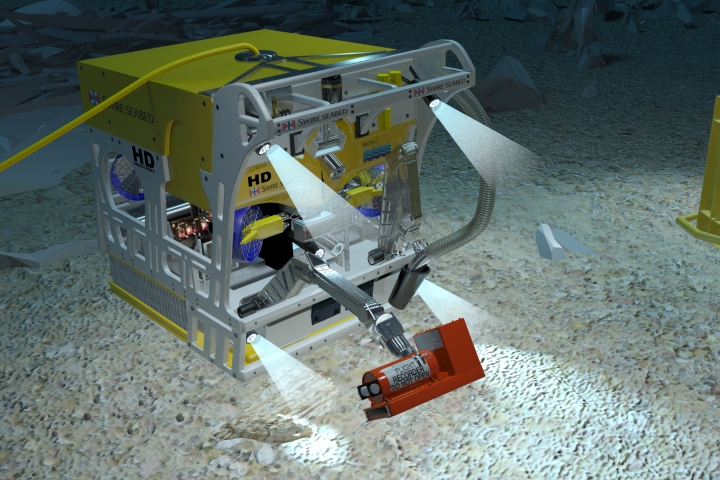
“About 2 degrees to starboard and slow down to 3 knots,” I said to Captain Steve Evert of Stockton College’s Marine field Station.  We were surveying the Robert J. Walker shipwreck, using the latest in side scan sonar technology to remotely produce a picture of the wreck.
We were surveying the Robert J. Walker shipwreck, using the latest in side scan sonar technology to remotely produce a picture of the wreck.
Side scan sonar is a towed sonar which creates overhead images of the sea floor using sound rather than the light used in photography. The in-water portion of the system called a towfish, skimmed the sea floor only feet from the sea bottom and the wreck. Pass after pass produced fantastic images of the wreck that no camera could capture.
The data was returned to the Stockton College Marine Field Station laboratory where the students processed hours of sonar data to create a diagram of the vessel as she lie on the bottom in 85 feet of water. I watched with fascination as students dove into the work and produced a diagram worthy of any commercial operation. I was very proud of what they had accomplished in such a short time.
In 1860, Robert J. Walker was one of the U.S. Coast Survey’s (predecessor organization to NOAA) new iron-hulled steam-powered survey vessels. She was cutting-edge. Previously, sailing vessels had carried out surveys to create charts.
The paddle wheeler was making her way up the Jersey coast when she collided with Fanny, a wooden coal schooner. The collision stove in the Walker’s iron plates, causing massive flooding. Valiant efforts by the crew to thwart the flood by stuffing wool blankets between the leaking iron plates was in vain. Twenty sailors lost their lives on that night, the largest single loss of NOAA personnel in its history. These gallant officers and sailors are memorialized in NOAA’s Hall of Honor.

While the wreck was initially found in 1970, she wasn’t officially identified until about a year ago with NOAA and associated partners, divers and archaeologists. The latest in high-resolution multi-beam side scan sonar and ROV imagery were used to finally make a positive identification.
Now the wreck has become an important historical and archaeological site and one on which a team of Stockton undergraduate students as well a community divers, assisted by NOAA personnel, lead by my colleague Dr. James Delgado, will be mapping in detail during an August expedition.
The 1847-built Robert J. Walker mapped navigational routes and created charts until her demise in 1860. With the impending U.S. Civil War, the ship was in full-out survey mode to ensure vulnerable ports and coastlines were mapped.

Remains of RJ Walker Paddle Wheel – Courtesy of NOAA

Today, some 154 years later, coastal mapping involves sophisticated sonars. These sonars produce images of the sea floor and measure ocean depth. Students at the Stockton Marine Field Station learn how to operate these new technologies as part of a special summer internship. Reviewing the sonar data with the students, we see evidence of the once-proud vessel now degraded by the ocean into the barely recognizable remains of the boiler and engines.

Students Walt, Jamie, Chelsea and Emily, learned the art of advanced sonar image interpretation as well as how to operate the newest EdgeTech multi-beam side scan sonar. Analysis of the sonar data provided divers a working map of the wreck. This preliminary diagram of the vessel remains allows divers to efficiently plan their working dives. Groups of divers will map different portions of the shipwreck in detail. Each dive team will record minute details from which a final drawing will be created and presented to NOAA.
In preparation for the archaeological dives, a workshop was held at Stockton College where Joyce Steinmetz, an archaeologist from East Carolina University, met with Stockton students and Atlantic divers and spoke about her work on the wreck — she used NOAA multi-beam to confirm measurements of portions of the wreck. Additionally, Ben Lieb is training divers on the mapping techniques and the measurements he wants taken.
Robert J. Walker sank in just 30 minutes early on June 21, 1860, and the dead outnumber any other sinking of a U.S. Coast Survey or NOAA vessel. The shipwreck has been added to the National Register of Historic Places to recognize the service and sacrifice the crew gave to their duties and their country.

The 20 officers and seamen are recognized on NOAA’s Hall of Honor having lost their lives in the line of duty.
Robert J. Walker is a unique representation of the new age of steam technology and iron-hulled ships that were coming onto the commercial maritime seascape at the beginning of the 19th century. This project bridges the past and the future.
Past cutting-edge technologies studied by future generations of marine scientists and archaeologists.

As part of an Explorer’s Club Expedition (Flag # 132) led by Captain Steve Nagiewicz and Dan Lieb divers will descend on the wreck again today to complete the mapping effort. The final diagram, a combination of Stockton’s remote sensing and diver mapping will be compiled into a beautiful drawing of the vessel as she lies on the ocean floor today.


